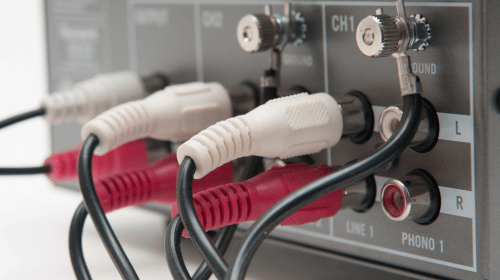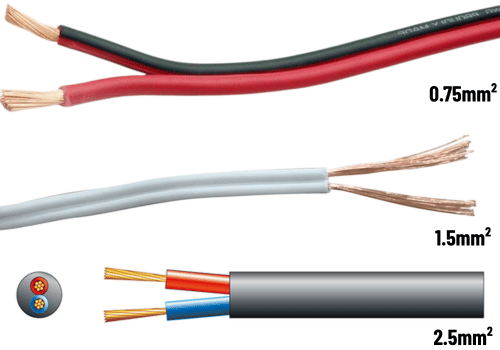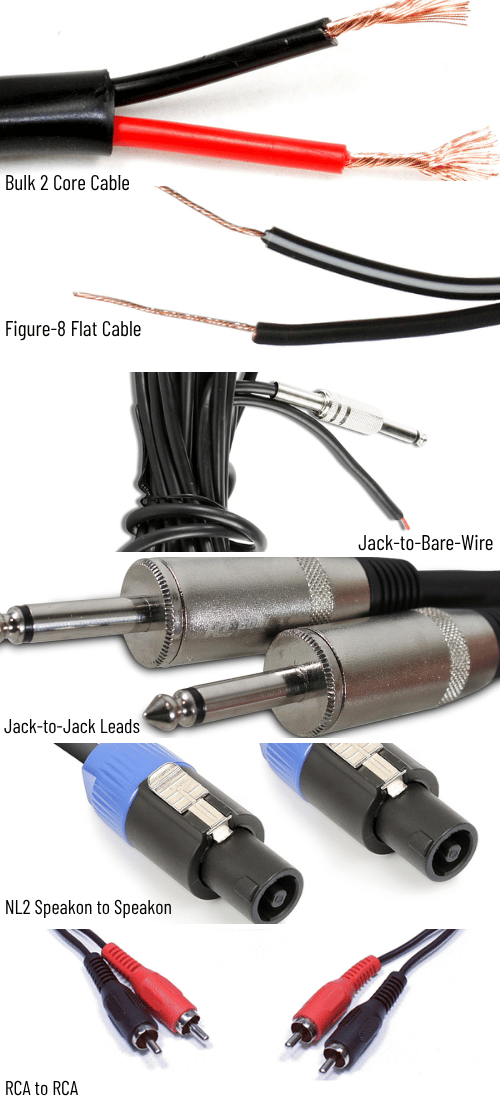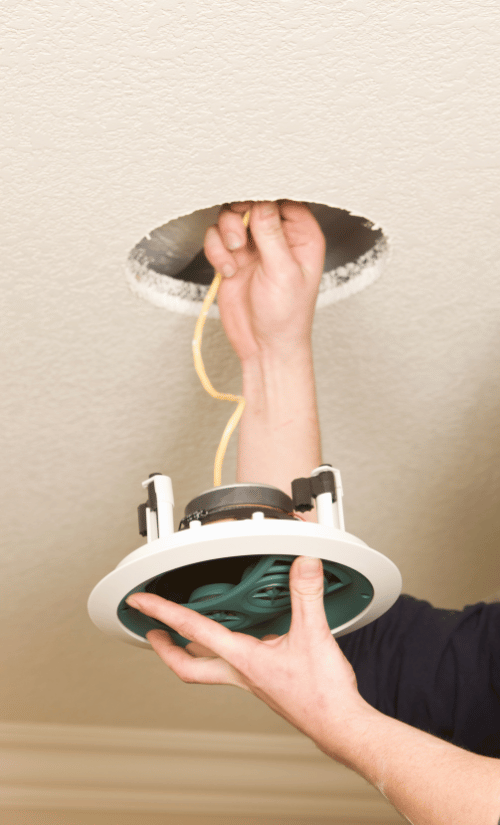

When building or upgrading an audio system, it’s easy to focus on speakers and amplifiers while overlooking one of the most critical components: the speaker cable. While often underestimated, choosing the right cable plays a major role in sound clarity, safety, and overall system performance. Whether you're setting up a home hi-fi system, a live stage rig, or a commercial background music setup, using the correct cable ensures reliable, distortion-free audio transmission.
This guide will walk you through the different types of speaker cables available, what they’re used for, and how to select the best option for your specific needs. By the end, you’ll be better equipped to make informed decisions and avoid common pitfalls when purchasing speaker cable.
Why Cable Quality Matters
Speaker cables are the physical link between your amplifier and your speakers - they carry the electrical audio signals that become the sound you hear. The quality of these cables can have a significant impact on audio performance. Poor-quality or mismatched cables can result in resistance that weakens the signal, introduce noise or interference, and even pose safety risks in more demanding environments.
One of the key things to look at is cable gauge - a measure of the thickness of the wire inside. Thicker cables (with lower gauge numbers) can carry more current and are better suited for longer runs or high-power systems. The material also matters. Copper is commonly used due to its excellent conductivity, but not all copper cables are created equal - oxygen-free copper (OFC), for example, offers lower resistance and better performance over distance.
In commercial installations, particularly those using 100V line systems, cable losses over distance can become a major issue. As explained in our guide to 100V line speaker cable lengths and losses, using the wrong gauge or poor-quality cable over long runs can result in significant signal degradation. This makes it all the more important to match the cable to your application, not just by connector type, but also by performance rating.
What Is Speaker Cable?
Speaker cable is a type of electrical cable designed specifically to carry audio signals from an amplifier or receiver to a loudspeaker. Unlike RCA cables, which transmit line-level signals and are shielded for interference, speaker cables carry higher current and are unshielded. They’re also very different from power cables, which are built for supplying electricity to devices rather than transmitting audio signals.
A typical 2 core speaker cable consists of two copper wires insulated from each other - one for positive, one for negative. These cables form the vital link in any audio setup, ensuring the amp’s signal reaches the speaker cleanly and efficiently.
Cable Gauge and Resistance
Cable gauge refers to the thickness of the internal wire and plays a major role in how well a cable performs - especially over distance. Thicker cables have lower resistance and are better at carrying power without losing signal strength.
Two common systems are used to describe this: square millimetres (mm²) and American Wire Gauge (AWG). While AWG is common in some countries, mm² is the standard in the UK.
Here’s a rough guide to help you choose based on cable run length:
- 0.75mm² – ideal for speaker runs up to 10 metres
- 1.5mm² – suitable for 10–30 metres
- 2.5mm² – recommended for longer runs or high-power systems
Choosing the best speaker cable means balancing length, speaker load, and amplifier power to ensure clean, consistent audio without drop-off.


Understanding Cable Specifications
Conductor Materials
The type of metal inside a speaker cable can make a real difference. The two most common options are:
OFC (Oxygen-Free Copper): High-purity copper that offers excellent conductivity and lower resistance. It’s more efficient at transmitting signal over longer distances and is the go-to choice for high-fidelity setups.
CCA (Copper-Clad Aluminium): This uses an aluminium core with a thin copper coating. It’s lighter and cheaper than OFC, but it comes with higher resistance. CCA can work well in budget systems or short runs, but it's not ideal for demanding applications.
For most reliable performance, especially where distance or clarity matters, OFC is the better long-term investment.
Core Count and Sheathing
Most audio setups use 2 core speaker cable - two insulated conductors, one for the positive terminal and one for negative. It's the standard for connecting single speakers. However, 4-core cable is also available and useful in more complex setups, such as bi-amping, bi-wiring, or running multiple zones from a central amplifier.
Cable shape also matters. Figure-8 cables are flat and easy to route under carpets or around corners, commonly used in domestic or low-profile installs. Round twin-core designs tend to be more robust and flexible, making them better for live sound or commercial use.
Environment Ratings
Where your cable is installed makes a big difference in what type you need. For example:
LSZH (Low Smoke Zero Halogen) cables are ideal in buildings where fire safety is critical - such as offices or public venues.
UV-resistant cables are designed to survive exposure to sunlight and won’t degrade outdoors.
Waterproof or weatherproof cables are needed for garden speakers or marine applications, ensuring durability even in damp or rainy conditions.
Choosing cables rated for the environment they're in isn’t just about longevity - it’s also about safety and compliance.


Main Types of Speaker Cables
There are several types of speaker cables to choose from, each suited to a different purpose. Whether you're wiring a permanent installation, connecting portable gear, or building a custom system from scratch, selecting the right cable format is essential.
Bulk 2 Core Cable (Bare Wire)
For custom installations or wiring inside walls, bulk cable reels offer the most flexibility. The PD Connex RX12 2-Core Copper Speaker Cable – 100m is a solid choice. It features 2 x 1.5mm² pure copper cores and a durable black PVC jacket. The cable includes polarity markings (typically a stripe on one conductor) to help ensure correct wiring - a small but important detail for avoiding phase issues. Its soft insulation is easy to strip, making install time quick and tidy.
Figure-8 Flat Cable
The Skytronic 2-Core Figure-8 Speaker Cable – 100m has a slim, flat profile ideal for domestic installs. Because it lies flush, it's perfect for routing along skirting boards or under carpets. While it's not suited to very long runs or high-powered systems, it works brilliantly for modest home setups or background music zones.
Jack-to-Bare-Wire Leads
The Vonyx 6.35mm Jack to Bare Wire – 6.0m is ideal for connecting amplifiers or powered mixers with jack outputs to passive speakers that use bare wire terminals. It's a great plug-and-play solution for simple PA or rehearsal room setups.
Pre-Made Jack-to-Jack Leads
For portable rigs, pre-terminated cables save time and reduce the chance of wiring errors. Both the PD Connex CX2915 – 15m Jack to Jack and the Vonyx CX30015 – 15m Jack to Jack are built for live sound use with strong plugs and thick jackets. Ideal for mobile DJs, bands, or event techs on the go. Be sure to use Jack-to-Jack cable that is not for instruments as this would be a different type of cable (such as guitar leads). They look similar but they aren’t the same.
NL2 Speakon to Speakon Cables
For high-powered systems, lockable Speakon connectors are the professional standard. The Vonyx CX30210 – NL2 to NL2 10m offers secure connection and robust build quality. These are perfect for PA systems, live sound, and touring rigs where reliability under load is crucial.
RCA to RCA Leads
While not technically a speaker cable, the Skytronic 2x RCA Cable – 1.5m is commonly used to connect source devices like CD players or media players to active speakers or amplifiers. RCA cables carry line-level signals, not speaker-level current, so they’re suited for signal routing rather than speaker outputs.
Choosing the Best Speaker Cable for Your Setup
The right speaker cable depends on where and how you're using it. Here's a breakdown of common setups with suitable options:
For Home Hi-Fi Systems
For casual music listening or home theatre, 0.75mm² to 1.5mm² cable is generally sufficient:
In small to medium rooms, the Skytronic Figure-8 100m offers a compact and easy-to-hide solution.
For more flexibility or longer runs, go with the PD Connex RX12 2-Core 1.5mm², which provides better conductivity.
For DJ/PA Use
Durability and speed of setup are key here. Rugged pre-terminated cables are a must:
PD Connex CX2915 Jack to Jack – 15m – great for smaller speakers or monitors.
Vonyx CX30210 NL2 to NL2 – 10m – perfect for larger speakers using Speakon connectors.
For 100V Line Installations
In commercial setups where long cable runs are common, resistance becomes a critical factor. Follow guidance from the 100V Line Cable Loss Guide and use low-resistance copper cable:
PD Connex RX12 – 1.5mm² Copper Reel is a solid option for most 100V installs.
For Outdoor/Garden Audio
Use shielded, durable cable protected by conduit, especially where it might be exposed to moisture:
Bulk cable like PD Connex RX12 in 2.5mm² (for longer runs or high volume setups) is ideal when routed in proper weatherproof conduit.
Cable Length and Losses
As speaker cable length increases, so does the potential for voltage drop - where the signal weakens due to resistance in the cable. Over long distances, especially in high-impedance or 100V systems, this can lead to reduced volume, loss of clarity, and uneven speaker performance across zones.
To avoid this, it’s essential to match the cable gauge (thickness) to the distance and power required. Copper cable offers lower resistance, and using thicker cables (lower gauge or higher mm²) will help maintain signal integrity over long runs.
Here’s a simplified guide:
- Up to 10m: 0.75mm² cable
- 10–30m: 1.5mm² cable
- 30m+ or high-power systems: 2.5mm² cable or larger
- 100V line systems: Always minimise resistance – use the thickest cable practical for the run
For a detailed explanation, check out our guide on 100V line speaker cable lengths and losses.
Remember: Choosing the best speaker cable isn’t just about quality - it’s about the right size for the right job.


How to Wire and Terminate Speaker Cable
Polarity Check
Correct polarity ensures your speakers work together, not against each other. Always connect the + (positive) terminal on your amplifier to the + on the speaker, and likewise for – (negative). If a speaker is wired in reverse polarity, it will move out of phase with others, leading to poor stereo imaging, weak bass, and an overall thin sound. Some cables have a stripe or colour on one conductor to make polarity easier to follow.
Common Connector Types
There are several ways to terminate speaker cables depending on your equipment:
- Bare wire – Ideal for terminals with spring clips or screw-down connectors.
- Banana plugs – Handy for quick connects to home audio receivers.
- Spade connectors – Secure and neat, commonly used in hi-fi.
- 6.35mm jack – Found on many PA amplifiers and older gear.
- NL2 Speakon – Locking, robust, and standard in professional audio.
Make sure connectors match both the cable thickness and the input/output types of your gear.
Series vs Parallel Wiring
When connecting multiple speakers to one amplifier channel, you can wire them in series or parallel.
Series increases total impedance, which may reduce overall output.
Parallel keeps voltage stable but may drop impedance too low, risking amp overload.
For a deeper dive into wiring methods and diagrams, see our guide: How to Wire Speakers in Parallel or Series.
FAQs
What’s the best speaker cable for home audio?
For most home hi-fi systems, a 2 core speaker cable with 0.75mm² or 1.5mm² copper conductors works perfectly. The Skytronic figure-8 cable is a great, budget-friendly choice, while PD Connex reels offer high-quality copper for longer runs.
Can I use 2-core electrical wire as speaker cable?
While it's physically possible, it’s not recommended. Electrical wire isn't optimised for audio and often lacks the flexibility and low-resistance copper required for clean signal transfer. Always choose purpose-built speaker cables.
What’s the difference between RCA and speaker cables?
RCA cables carry low-level audio signals between devices like CD players and amps. Speaker cables, on the other hand, transmit high-power signals from the amplifier to the speakers. They’re not interchangeable.
How long can a speaker cable be without losing quality?
It depends on the gauge. Generally, keep runs under 10m with 0.75mm², under 30m with 1.5mm², and use 2.5mm² or thicker for longer distances to avoid signal loss.
What gauge speaker wire should I use?
It’s all about distance and power. Short runs under 10m can use thinner cable like 0.75mm², but longer runs or high-power systems will benefit from thicker options like 1.5mm² or 2.5mm².
Conclusion
When it comes to audio performance, your choice of speaker cable matters. It's not just about finding the best speaker cable - it's about choosing the right cable for your setup, your distances, and your connectors. Whether you’re wiring a home stereo, a garden speaker, or a full-blown PA system, matching cable size and type to the job ensures your sound stays clean, consistent, and safe.




